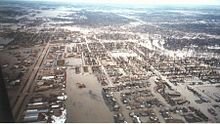National Flood Insurance Program

The National Flood Insurance Program (NFIP) is a program created by the Congress of the United States in 1968 through the National Flood Insurance Act of 1968 (P.L. 90-448). U.S. Congress has the twofold purposes of the NFIP to share the risk of flood losses through flood insurance and to reduce flood damages by restricting floodplain development. The program enables property owners in participating communities to purchase insurance protection, administered by the government, against losses from flooding, and requires flood insurance for all loans or lines of credit that are secured by existing buildings, manufactured homes, or buildings under construction, that are located in the Special Flood Hazard Area in a community that participates in the NFIP. U.S. Congress limits the availability of National Flood Insurance to communities that adopt adequate land use and control measures with effective enforcement provisions to reduce flood damages by restricting development in areas exposed to flooding.
This NFIP is designed to provide an insurance alternative to disaster assistance to meet the escalating costs of repairing damage to buildings and their contents caused by floods. As of August 2017, the program insured about 5 million homes (down from about 5.5 million homes in April 2010), the majority of which are in Texas and Florida. The cost of the insurance program was fully covered by its premiums until the end of 2004, but has had to steadily borrow funds since (primarily due to Hurricane Katrina and Hurricane Sandy), accumulating $25 billion of debt by August 2017. In October 2017, Congress cancelled $16 billion of NFIP debt, making it possible for the program to pay claims. The NFIP owes $20.525 billion to the U.S. as of December 2019.
Comments
Post a Comment